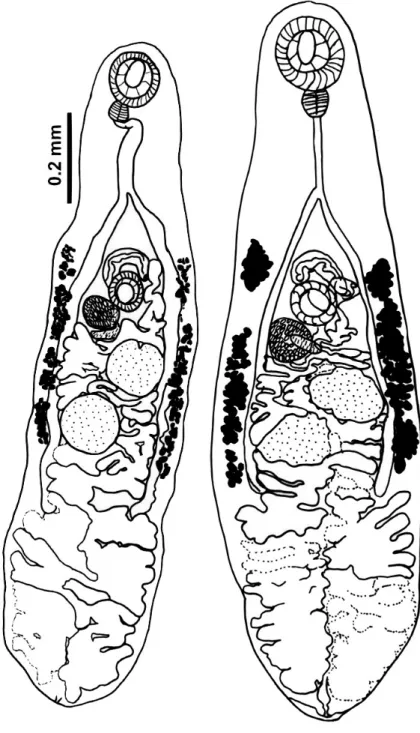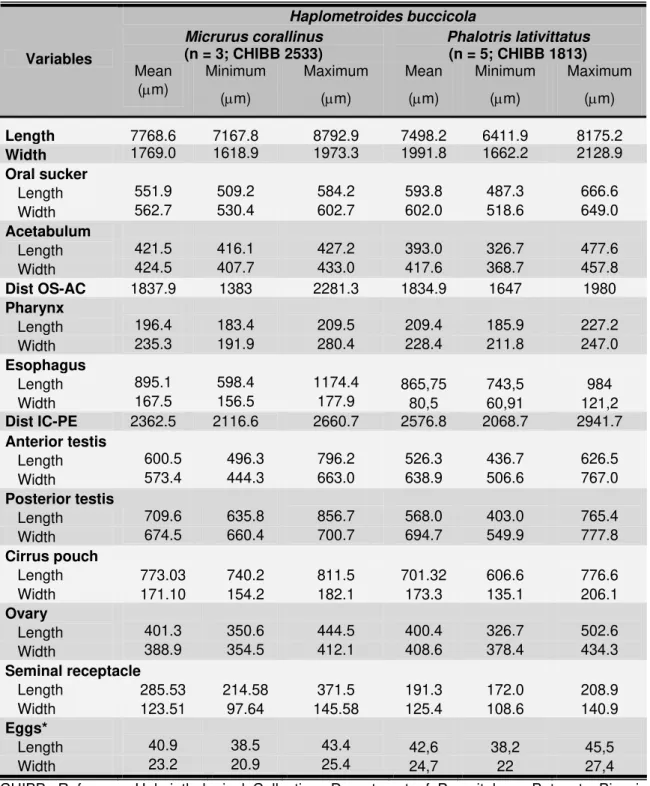Full paper published online: August 31, 2008 ISSN 1678-9199.
NEW REPORTS ON PARASITISM BY Haplometroides buccicola (DIGENEA, PLAGIORCHIIDAE) IN BRAZILIAN SNAKES
SANTOS KR (1), BARRELLA TH (2), ZICA EOP (2), SILVA RJ (3)
(1) Graduate Program in Veterinary Medicine, Veterinary Medicine and Animal Husbandry School, São Paulo State University, UNESP, São Paulo State, Brazil; (2) Graduate Program in General and Applied Biology, Botucatu Biosciences Institute, São Paulo State University, UNESP, São Paulo State, Brazil; (3) Department of Parasitology, Botucatu Biosciences Institute, São Paulo State University, UNESP, Botucatu, São Paulo State, Brazil.
ABSTRACT: The occurrence of Haplometroides buccicola (Digenea, Plagiorchiidae)
in the esophagus of two Brazilian snakes is reported in the present study. The trematodes were collected from one Micrurus corallinus (Elapidae) and one Phalotris
lativittatus (Colubridae); both snakes were found in Botucatu city, São Paulo State,
Brazil. Morphological and morphometric analyses of the trematodes are presented. For the first time Micrurus corallinus has been recorded as a host for H. buccicola
and this is the second time that P. lativittatus has been reported as a host for this
trematode species.
KEY WORDS: Haplometroides buccicola, Plagiorchiidae, Phalotris lativittatus, Micrurus corallinus, snakes.
CONFLICTS OF INTEREST: There is no conflict.
CORRESPONDENCE TO:
REINALDO J. SILVA, Departamento de Parasitologia, Instituto de Biociências, Universidade Estadual Paulista, Distrito de Rubião Júnior, 18618-000, Botucatu, SP, Brasil. Phone: +55 14 38116239. Fax: +55 14 38153744. Email:
INTRODUCTION
The current study aimed to report the occurrence of Haplometroides buccicola
(Digenea, Plagiorchiidae) in a new host, Micrurus corallinus (Serpentes, Elapidae),
and also the second case of infection by this trematode species in Phalotris
lativittatus (Serpentes, Colubridae).
The host snakes were captured in the municipality of Botucatu, São Paulo State, and were donated to the Center for the Study of Venoms and Venomous Animals (CEVAP) of São Paulo State University (UNESP). In both snakes trematodes were found in their esophagus. Three helminthes were collected in M. corallinus and nine
in P. lativittatus. The trematodes were fixed in AFA (alcohol-formol-acetic acid) under
slight pressure of a coverslip for 10 minutes, and then transferred to 70% alcohol for further processing. The specimens were stained with carmine and cleared in creosote.
Morphological and morphometric analyses were accomplished in a computerized imaging system (Qwin Lite 3.1®, Leica, Germany). Measurements for the specimens are reported as the mean and range (minimum-maximum).
The trematodes were deposited in the Reference Helminthological Collection (CHIBB) of the Department of Parasitology, Botucatu Biosciences Institute, UNESP. The trematodes (Figure 1, Table 1) presented: tegument covered with spines; oral subterminal sucker; prepharynx not evident; muscular pharynx; short and narrow esophagus; slightly sinuous intestinal ceca (distributed until the testicular region); pre-equatorial acetabulum; preacetabular, postbifurcal, submedian genital pore, opening near the right cecal branch; small cirrus pouch positioned behind the acetabulum and presenting an opposed curvature beside the ovary; ovoid testes with irregular contours, in a diagonal, postacetabular and intercecal position; ovoid ovary just behind the acetabulum, with regular contours, pre-testicular, intercecal; a Mehlis’ gland located below and on the right ovary portion; a seminal receptacle posterior to the Mehlis’ gland; vitellaria consisting of few bunched developed follicles, in a lateral and extracecal position, distributed from the zone slightly anterior to the genital pore to the testicular zone; a well-developed uterus, occupying most of the post-testicular zone; a long and narrow vagina; ovoid, operculated and thick shelled eggs with two small, apical lateral protuberances; terminal excretory pore.
The Haplometroides species found in M. corallinus and P. lativittatus was identified
included in the family Plagiorchiidae (9) and only three snake parasite species have been described for this genus: H. buccicola (2), H. odhneri (4) and H. intercaecalis
(7).
Haplometroides buccicola was previously reported in snakes from several South
American countries. Odhner (2) found this trematode in a specimen of Micrurus sp.
(= Elaps sp.) from Paraguay. After, this helminth species was reported in Micrurus
frontalis from Argentina (3) and Brazil (6). Micrurus lemniscatus (4), Leptotyphlops koppesi (8), Phalotris lativittatus (5) and Epicrates cenchria crassus (4) were other
hosts recorded in Brazil for H. buccicola.
The present study reports the first case of infection by H. buccicola in M. corallinus.
Elapid snakes have been reported as hosts for this trematode (2, 3, 4, 6). However, despite the large geographic distribution of M. corallinus (1), this is the first report on
the helminth fauna of this snake in Brazil.
With regard to P. lativittatus, only one case of infection by the trematode exists in the
literature. Silva et al. (5) reported the occurrence of H. buccicola in a P. lativittatus
specimen deposited in the Herpetological Collection of CEVAP. The trematodes were collected from the mouth and esophagus of the snake, but the helminthes were in inadequate conditions for the morphometric analysis since they were fixed incorrectly inside the snake organs. In the in toto preparations, the worms were bent, crooked or
kneaded, which hindered not only the measuring, but also the illustration of the trematodes. The present study is the second report of H. buccicola occurrence in P.
lativittatus, thus confirming this species as a host. In this study, the trematodes were
Figure 1. Haplometroides buccicola (Digenea, Plagiorchiidae) from the esophagus of
Table 1. Morphometric data of Haplometroides buccicola found in the esophagus of
Micrurus corallinus (Elapidae) and Phalotris lativittatus (Colubridae) from the
municipality of Botucatu, São Paulo, Brazil
Haplometroides buccicola Micrurus corallinus
(n = 3; CHIBB 2533)
Phalotris lativittatus (n = 5; CHIBB 1813) Variables
Mean (μm)
Minimum (μm)
Maximum (μm)
Mean (μm)
Minimum (μm)
Maximum (μm)
Length 7768.6 7167.8 8792.9 7498.2 6411.9 8175.2 Width 1769.0 1618.9 1973.3 1991.8 1662.2 2128.9 Oral sucker
Length 551.9 509.2 584.2 593.8 487.3 666.6
Width 562.7 530.4 602.7 602.0 518.6 649.0
Acetabulum
Length 421.5 416.1 427.2 393.0 326.7 477.6
Width 424.5 407.7 433.0 417.6 368.7 457.8
Dist OS-AC 1837.9 1383 2281.3 1834.9 1647 1980 Pharynx
Length 196.4 183.4 209.5 209.4 185.9 227.2
Width 235.3 191.9 280.4 228.4 211.8 247.0
Esophagus
Length 895.1 598.4 1174.4 865,75 743,5 984
Width 167.5 156.5 177.9 80,5 60,91 121,2
Dist IC-PE 2362.5 2116.6 2660.7 2576.8 2068.7 2941.7
Anterior testis
Length 600.5 496.3 796.2 526.3 436.7 626.5
Width 573.4 444.3 663.0 638.9 506.6 767.0
Posterior testis
Length 709.6 635.8 856.7 568.0 403.0 765.4
Width 674.5 660.4 700.7 694.7 549.9 777.8
Cirrus pouch
Length 773.03 740.2 811.5 701.32 606.6 776.6
Width 171.10 154.2 182.1 173.3 135.1 206.1
Ovary
Length 401.3 350.6 444.5 400.4 326.7 502.6
Width 388.9 354.5 412.1 408.6 378.4 434.3
Seminal receptacle
Length 285.53 214.58 371.5 191.3 172.0 208.9
Width 123.51 97.64 145.58 125.4 108.6 140.9
Eggs*
Length 40.9 38.5 43.4 42,6 38,2 45,5
Width 23.2 20.9 25.4 24,7 22 27,4
CHIBB: Reference Helminthological Collection, Department of Parasitology, Botucatu Biosciences Institute, UNESP, Botucatu, São Paulo State, Brazil; Dist OS-AC: distance between oral sucker and acetabulum; Dist IC-PE: distance between intestinal ceca and posterior end of the body.
REFERENCES
1 CAMPBELL JA., LAMAR WW. The venomous reptiles of Latin America. New
York: Cornell University Press, 1989. 425p.
2 ODHNER T. Nordostafrikanische Trematoden grösstenteils vom Weissen Nil (von der Schwedischen Zoologischen Expedition gesammelt). Res. Swed. Zool. Exp.
to Egypt and the White Nile, 1911, 4, 1-166.
3 POUMARAU EMC. Trematodes de ofidios de la Argentina. Rev. Mus. Argent.
Cienc. Nat. Bernardino Rivadavia Inst. Nac. Investig. Cienc. Nat. Parasitol., 1968, 1,
1-129.
4 RUIZ JM., PEREZ MD. Gênero Haplometroides. Redescrição da espécie-tipo e
descrição de H. odhneri sp. n. (Trematoda: Plagiorchiidae). An. Fac. Farm. Odontol.
Univ. São Paulo, 1959, 16, 87-91.
5 SILVA RJ., ANDRADE PA., MONTEIRO E SILVA HA., ROSSELLINI M., BARRELLA TH. Report on the occurrence of Haplometroides buccicola (Trematoda,
Digenea, Plagiorchiidae) infecting Phalotris lativittatus (Serpentes, Colubridae) in
Brazil. J. Venom. Anim. Toxins incl. Trop. Dis., 2005, 11, 373-9.
6 SILVA RJ., BARRELLA TH. Micrurus frontalis as a new host recorded for
Haplometroides odhneri (Trematoda, Digenea, Plagiorchiidae). Rev. Bras. Parasitol. Vet., 2002, 11, 47-8.
7 SILVA RJ., FERREIRA VL., STRÜSSMANN C. New species of Haplometroides
(Digenea, Plagiorchiidae) from Phalotris nasutus (Gomes, 1915) (Serpentes,
Colubridae). J. Parasitol., 2007, 93, 917-21.
8 SILVA RJ., ZICA EOP., CRUZ M., O’REILLY JC., COSTA MC. Occurrence of
Haplometroides odhneri (Trematoda, Digenea, Plagiorchiidae) infecting Leptotyphlops koppesi (Serpentes, Leptotyphlopidae). Arq. Bras. Med. Vet. Zootec.,
2004, 57, 267-9.
9 YAMAGUTI S. Synopsis of digenetic trematodes of vertebrates. Tokyo: Keigaku

